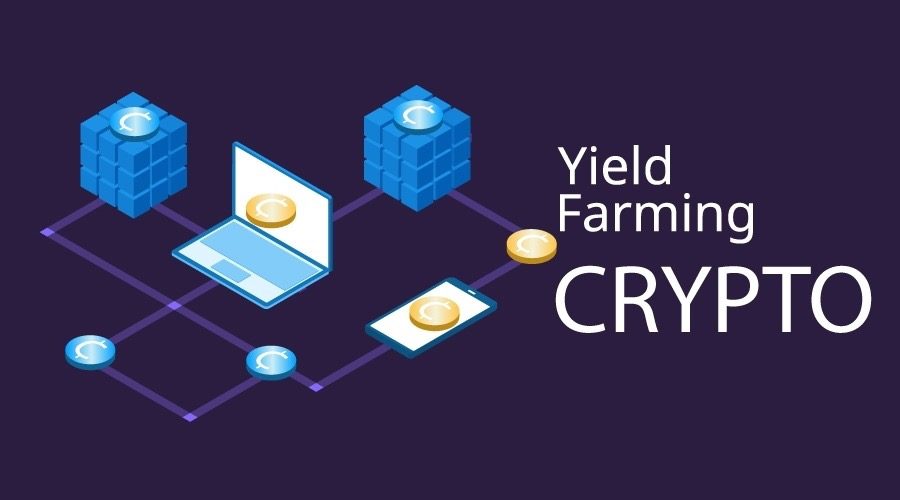Yield farming is a relatively new concept that has recently gained traction in the cryptocurrency space. It is a strategy that involves using crypto assets to earn rewards from a variety of sources in a single investment. Yield farming is a way to generate passive income and take advantage of the benefits of the DeFi (decentralized finance) ecosystem.
In this blog post, we will explain what yield farming is, how it works, and how to get started.
What is Yield Farming?
Yield farming is a type of decentralized finance (DeFi) investment strategy that involves using cryptocurrencies to generate passive income. Essentially, yield farming involves lending or providing liquidity to DeFi protocols, in return for earning rewards, such as interest payments, transaction fees, or tokens.
Yield farming is made possible by DeFi protocols that utilize smart contracts to automate lending, borrowing, and trading. These protocols often incentivize users to provide liquidity by offering higher interest rates or token rewards.
Yield farming has become increasingly popular due to its potential to generate high returns, sometimes even surpassing traditional investment vehicles. However, it’s important to note that yield farming is a complex investment strategy that involves various risks, including the possibility of losing money due to price volatility or hacking incidents.
Before investing in yield farming, it’s important to thoroughly research the protocols and understand the risks involved.
How Does Yield Farming Work?
 Yield farming is a decentralized finance (DeFi) practice that allows investors to earn rewards in the form of additional tokens by lending or staking their cryptocurrency. This process involves depositing assets into a liquidity pool, which allows the platform to facilitate trading and earn fees.
Yield farming is a decentralized finance (DeFi) practice that allows investors to earn rewards in the form of additional tokens by lending or staking their cryptocurrency. This process involves depositing assets into a liquidity pool, which allows the platform to facilitate trading and earn fees.
In return for their contribution to the pool, investors are issued with liquidity pool tokens (LPTs). These LPTs represent their share of the pool, and they can be traded or held as they continue to generate more tokens through yield farming.
The amount of rewards earned depends on the level of participation in the pool, which can vary from platform to platform. Yield farming allows investors to earn passive income by holding onto their cryptocurrency and participating in the network’s growth. This is because yield farming is based on the principle of supply and demand, and as the demand for liquidity increases, the value of the tokens generated through yield farming increases as well.
However, yield farming is not without risks. The DeFi space is known for its volatility, and investors can lose their investment due to market crashes, hacking, and fraud. Additionally, the reward tokens generated by yield farming are often new and untested, and their value can fluctuate drastically.
As a result, it’s important to conduct thorough research before participating in yield farming and to exercise caution when choosing which protocols to use.
Benefits of Yield Farming
Yield farming offers several potential benefits to investors in the cryptocurrency space. Firstly, it provides an opportunity to earn passive income through the utilization of crypto assets. By participating in yield farming, investors can earn rewards such as interest payments, transaction fees, or newly issued tokens. This can be particularly attractive for individuals looking to make their crypto holdings work for them and generate additional income.
Another benefit of yield farming is the potential for higher returns compared to traditional investment vehicles. Due to the nature of DeFi protocols and the incentives offered to liquidity providers, yield farming can sometimes generate significantly higher yields.
This has attracted many investors seeking to maximize their returns in the volatile cryptocurrency market.
Yield farming also allows investors to participate in the decentralized finance ecosystem. By lending or providing liquidity to DeFi protocols, investors contribute to the growth and development of the DeFi space. This can be seen as supporting the future of finance and technology, while also potentially benefiting from the value appreciation of the tokens earned through yield farming.
Lastly, yield farming provides a level of flexibility and choice to investors. With a wide range of protocols and platforms available, investors can choose the ones that best align with their risk appetite and investment goals. This allows for customization and diversification within the yield farming strategy.
It is important to note that while there are potential benefits to yield farming, it is not without risks. Investors should thoroughly research and understand the risks involved before participating in yield farming activities.
Risks Associated with Yield Farming
Yield farming, like any investment strategy, comes with its own set of risks that investors should be aware of before getting involved. One of the main risks is the high level of volatility in the cryptocurrency market. Cryptocurrencies are known for their price fluctuations, and yield farming is not exempt from this. The value of the tokens earned through yield farming can be highly volatile, which means investors may experience significant losses if the market crashes or if the value of the tokens decreases rapidly.
Another risk associated with yield farming is the potential for hacking or fraud. While decentralized finance (DeFi) protocols strive to provide secure platforms, they are not immune to cyber attacks. If a protocol is hacked or if there is a security breach, investors may lose their funds. It’s important to thoroughly research and choose reputable protocols with strong security measures in place.
Additionally, yield farming requires investors to lock up their funds for a certain period of time. This lack of liquidity can be a risk, especially if there is an urgent need for the invested funds. It’s crucial to consider the lock-up period and assess whether it aligns with your financial goals and needs.
Lastly, the yield farming space is constantly evolving, and there is a risk of investing in protocols or tokens that may not succeed or have a sustainable future. It’s essential to carefully evaluate the protocols and tokens you choose to invest in and to stay informed about any potential changes or developments in the industry.
Read Also: How to Sell Amazon Gift Cards for Bitcoin
Types of Yield Farming Strategies
Yield farming involves several strategies to maximize returns, and they fall into three main categories:
- Liquidity Provision Strategies: This is the most popular type of yield farming strategy, where investors provide liquidity to automated market makers (AMMs). The AMMs allow traders to swap tokens instantly, and investors earn fees for providing liquidity. These strategies involve low risks and moderate returns.
- Token Staking Strategies: Investors can stake their tokens in a pool to earn rewards and boost network security. Token staking strategies involve higher risks and higher returns. However, investors must understand the token economics and the project’s roadmap before investing.
- Governance Participation Strategies: Investors participate in a protocol’s governance system to influence its development and decision-making process. Governance tokens allow holders to vote on changes to the protocol, such as fees, token distribution, and feature updates. Governance participation strategies involve higher risks and the potential for higher returns, as investors’ decisions can impact the project’s future success.
It’s essential to research the protocol and understand its mechanics before deploying any yield farming strategies. Each strategy has its advantages and risks, and investors must balance these to maximize returns.
Popular Yield Farming Protocols
Always conduct thorough research and due diligence before participating in any DeFi project. Here are some popular yield farming protocols as of my last update:
- Compound (COMP): Compound is one of the pioneering DeFi protocols that allows users to lend and borrow various cryptocurrencies. Users can earn interest on their deposited assets, and liquidity providers can earn COMP tokens as rewards.
- Aave (AAVE): Aave is a decentralized lending protocol that enables users to lend and borrow a wide range of cryptocurrencies. It offers an interest-bearing token called aTokens, and AAVE token holders can participate in governance and earn staking rewards.
- Yearn Finance (YFI): Yearn Finance is a yield aggregator that automates yield farming strategies to maximize returns for users. It provides users with a convenient way to access various DeFi platforms and protocols to optimize their yield farming opportunities.
- Synthetix (SNX): Synthetix is a platform that allows users to mint and trade synthetic assets representing real-world assets like stocks, commodities, and fiat currencies. Users can stake SNX tokens as collateral and earn rewards in the form of SNX and fees.
- Balancer (BAL): Balancer is an automated portfolio manager and decentralized exchange (DEX) that allows users to create liquidity pools with multiple tokens. Liquidity providers can earn BAL tokens as rewards based on their share of the pool.
- Uniswap (UNI): Uniswap is a decentralized exchange protocol that facilitates automated trading and liquidity provision. Users can provide liquidity to the platform’s liquidity pools and earn UNI tokens as rewards.
- Curve Finance (CRV): Curve Finance is a decentralized exchange optimized for stablecoin trading. Users can provide liquidity to stablecoin pools and earn CRV tokens as rewards.
- SushiSwap (SUSHI): SushiSwap is a decentralized exchange and AMM (Automated Market Maker) that enables users to earn SUSHI tokens by providing liquidity to its pools.
- PancakeSwap (CAKE): PancakeSwap is a decentralized exchange built on the Binance Smart Chain (BSC) and offers yield farming opportunities with CAKE tokens.
- Harvest Finance (FARM): Harvest Finance is a yield aggregator that aims to optimize returns on stablecoin deposits. Users can stake FARM tokens to earn a share of the platform’s revenue.
Remember that the DeFi space is subject to inherent risks, including smart contract vulnerabilities and market volatility. It’s essential to be cautious, start with small investments, and only participate in projects that you thoroughly understand.

